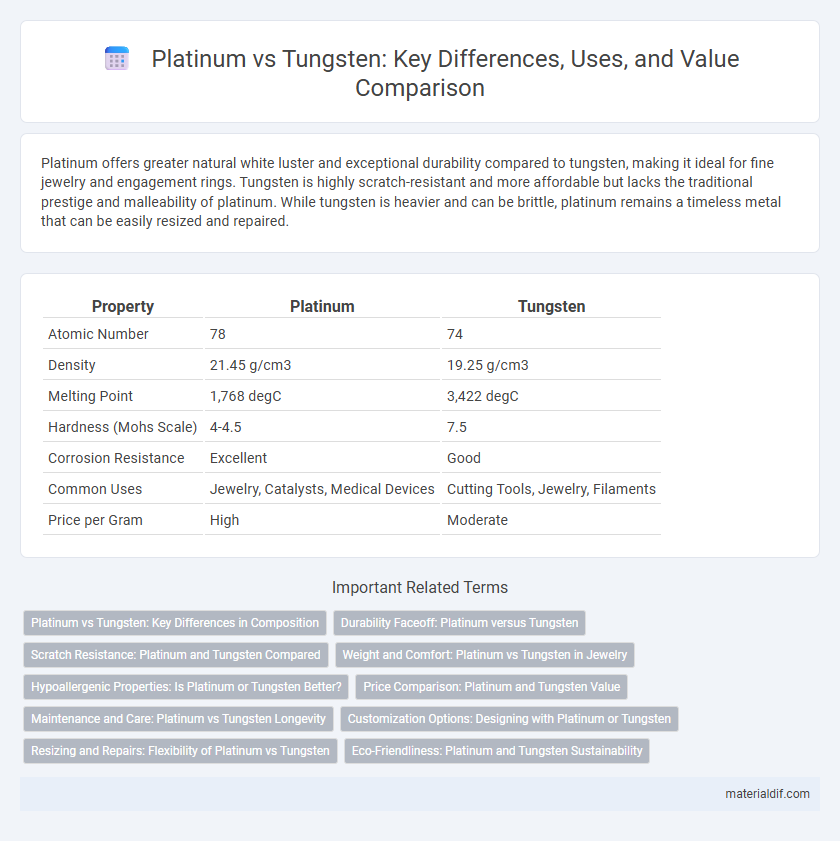Platinum offers greater natural white luster and exceptional durability compared to tungsten, making it ideal for fine jewelry and engagement rings. Tungsten is highly scratch-resistant and more affordable but lacks the traditional prestige and malleability of platinum. While tungsten is heavier and can be brittle, platinum remains a timeless metal that can be easily resized and repaired.
Table of Comparison
| Property | Platinum | Tungsten |
|---|---|---|
| Atomic Number | 78 | 74 |
| Density | 21.45 g/cm3 | 19.25 g/cm3 |
| Melting Point | 1,768 degC | 3,422 degC |
| Hardness (Mohs Scale) | 4-4.5 | 7.5 |
| Corrosion Resistance | Excellent | Good |
| Common Uses | Jewelry, Catalysts, Medical Devices | Cutting Tools, Jewelry, Filaments |
| Price per Gram | High | Moderate |
Platinum vs Tungsten: Key Differences in Composition
Platinum is a naturally occurring precious metal composed mainly of the element platinum (Pt), prized for its purity, corrosion resistance, and hypoallergenic properties. Tungsten, on the other hand, is a dense, hard metal primarily composed of the element tungsten (W), known for its high melting point and exceptional hardness but lacking the natural luster and malleability of platinum. The key differences in composition influence their applications in jewelry, with platinum's softness allowing intricate designs and tungsten's toughness offering scratch resistance.
Durability Faceoff: Platinum versus Tungsten
Platinum and tungsten both offer exceptional durability for jewelry, with tungsten being one of the hardest metals available, highly resistant to scratches and dents. Platinum, while slightly softer, boasts excellent strength and a unique ability to self-heal minor scratches over time due to its malleability. When choosing between durability and repairability, tungsten excels in scratch resistance, whereas platinum provides long-term resilience with the potential for refinishing.
Scratch Resistance: Platinum and Tungsten Compared
Platinum exhibits moderate scratch resistance due to its density and malleability, making it durable yet prone to surface scratches over time. Tungsten ranks higher in scratch resistance owing to its exceptional hardness, which is nearly twice that of platinum, maintaining its polish and shape under daily wear. While tungsten's superior scratch resistance makes it ideal for rugged use, platinum's unique luster and resistance to tarnish remain valuable for luxury jewelry.
Weight and Comfort: Platinum vs Tungsten in Jewelry
Platinum is significantly lighter than tungsten, making it more comfortable for all-day wear in jewelry such as rings and bracelets. Tungsten's density is about 19.25 g/cm3, nearly double that of platinum's 21.45 g/cm3, which can cause tungsten pieces to feel heavier and sometimes cumbersome. The superior comfort of platinum combined with its hypoallergenic properties makes it a preferred choice for sensitive skin compared to tungsten's hardness and weight.
Hypoallergenic Properties: Is Platinum or Tungsten Better?
Platinum exhibits superior hypoallergenic properties compared to tungsten, making it a better choice for individuals with sensitive skin or metal allergies. Unlike tungsten, which often contains nickel or cobalt alloys that can cause allergic reactions, platinum is a naturally hypoallergenic metal with high purity levels. This makes platinum ideal for jewelry that maintains skin safety and comfort over prolonged wear.
Price Comparison: Platinum and Tungsten Value
Platinum commands a significantly higher price than tungsten, with the metal trading at approximately $1,000 per ounce compared to tungsten's mere fraction of that value, often less than $10 per pound. The rarity and industrial demand for platinum in automotive catalytic converters and jewelry elevate its market price above tungsten, which is abundant and primarily valued for its hardness and use in manufacturing. Investors and consumers favor platinum for its intrinsic value and liquidity, whereas tungsten is prized more for its practical applications than as a precious metal investment.
Maintenance and Care: Platinum vs Tungsten Longevity
Platinum offers superior longevity with its natural resistance to tarnish and corrosion, requiring minimal maintenance compared to tungsten. Tungsten, while highly scratch-resistant, can be more prone to cracking or shattering under impact, necessitating careful handling over time. Platinum's ability to develop a unique patina enhances its durability and aesthetic appeal, making it a preferred choice for long-term jewelry investment.
Customization Options: Designing with Platinum or Tungsten
Platinum offers extensive customization options due to its malleability and ductility, allowing intricate designs, engravings, and fused gemstone settings that are difficult to achieve with tungsten. Tungsten's hardness restricts customization, often limiting designs to simple shapes and laser engravings rather than deep carvings or complex patterns. Choosing platinum enables more artistic freedom for bespoke jewelry, while tungsten suits those preferring durable, low-maintenance designs with minimal customization.
Resizing and Repairs: Flexibility of Platinum vs Tungsten
Platinum offers superior flexibility when it comes to resizing and repairs compared to tungsten, which is notoriously difficult to alter due to its extreme hardness and brittleness. Jewelers can easily resize platinum rings by soldering and reshaping, while tungsten's rigidity often necessitates ring replacement rather than modification. This makes platinum a more practical choice for those anticipating future adjustments or personalized customization.
Eco-Friendliness: Platinum and Tungsten Sustainability
Platinum is a highly sustainable metal due to its recyclability and longer lifespan, making it an eco-friendly choice in jewelry and industrial applications. Tungsten extraction often involves extensive mining processes that have a greater environmental impact compared to platinum's more efficient recycling systems. Choosing platinum supports reduced resource depletion and lower carbon emissions throughout its lifecycle.
Platinum vs Tungsten Infographic

 materialdif.com
materialdif.com